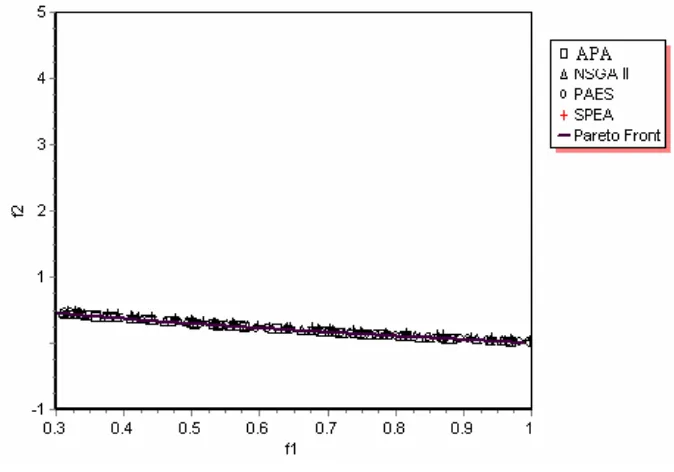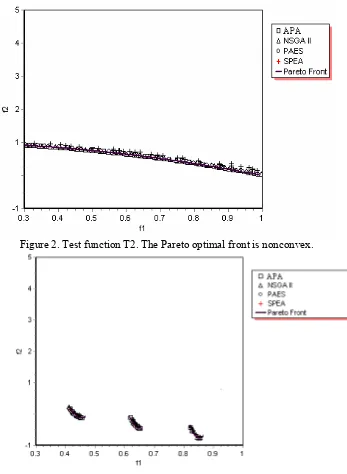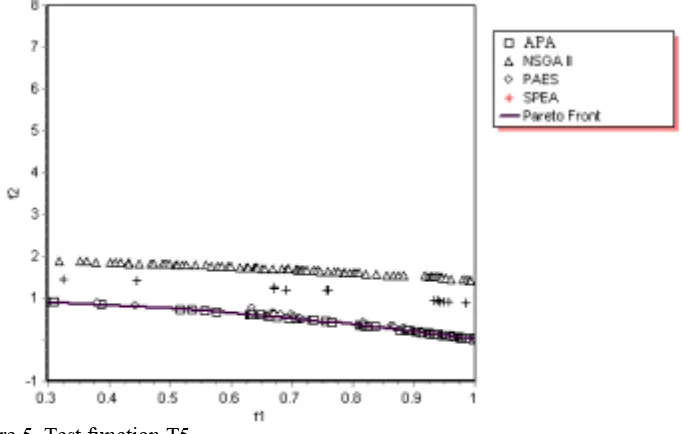A COMPARISON OF MULTIOBJECTIVE EVOLUTIONARY
ALGORITHMS
by
Crina Gro
ş
an and D. Dumitrescu
Abstract. In this paper a comparison of the most recent algorithms for Multiobjective Optimization is realized. For this comparison are used the followings algorithms: Strength Pareto Evolutionary Algorithm (SPEA), Pareto Archived Evolution Strategy (PAES), Nondominated Sorting Genetic Algorithm (NSGA II), Adaptive Pareto Algorithm (APA). The comparison is made by using five test functions.
Keywords: Evolutionary Computation, Evolutionary Multiobjective Optimization, Pareto Set, Higher Alphabet Encoding.
1.Introduction
In the last years many multiobjective optimization algorithms have been proposed. Strength Pareto Evolutionary Algorithm (SPEA, [11]), Pareto Archived Evolution Strategy (PAES, [6]), Pareto Envelope – based Selection Algorithm (PESA, [1]), Nondominated Sorting Genetic Algorithm (NSGA II, [3]) and SPEA II ([12]), Adaptive Pareto Algorithm (APA, [4], [5]) are some of them.
In this paper we realize a comparison of some of them. For this comparison are used five test functions introduced by Zitzler and Deb in [9].
The paper is structured as follows: section 2 is a short resume of the principal recent evolutionary techniques for multiobjective optimization and in the section 3 a comparison of some recent evolutionary techniques is realized.
2.Recent MOEAs
In the last years a number of evolutionary algorithms for multiobjective optimization have been proposed. Some of them will be shortly reviewed here.
2.1.Strength Pareto Evolutionary Algorithm (SPEA)
than the worst fitness of any nondominates solutions. A deterministic clustering technique is used to ensure diversity among nondominates solutions.
2.2.Pareto Archived Evolution Strategy (PAES)
Knowles and Corne [6] have been proposed a simple evolutionary algorithm called Pareto Archived Evolution Strategy (PAES). In PAES one parent generates by mutation one offspring. The offspring is compared with the parent. If the offspring dominates the parent, the offspring is accepted as the next parent and the iteration continues. If the parent dominates the offspring, the offspring is discarded and the new mutated solution (new offspring) is generated. If the offspring and the parent do not dominate each other, a comparison set of previously nondominated individuals is used.
For maintaining population diversity along Pareto front, an archive of nondominated solutions is considered. A new generated offspring is compared with the archive to verify if it dominates any member of the archive. If yes, then the offspring enters the archive and is accepted as a new parent. The dominated solutions are eliminated from the archive. If the offspring does not dominate any member of the archive, both parent and offspring are checked for their nearness with the solution of the archive. If the offspring resides in the least crowded region in the parameter space among the members of the archive, it is accepted as a parent and a copy is added to the archive.
2.3.Nondominated Sorting Genetic Algorithm (NSGA)
K. Deb and his students [3] suggested a fast elitist Nondominated Sorting Genetic Algorithm (NSGA II). In NSGA II, for each solution x the number of solutions that dominate solution x is calculated. The set of solutions dominated by x is also calculated. The first front (the current front) of the solutions that are nondominated is obtained.
Let us denote by Si the set of solutions that are dominated by the solution xi. For each solution xi from the current front consider each solution xq from the set Si. The number of solutions that dominates xq is reduced by one. The solutions which remain nondominates after this reduction, will form a separate list. This process continues using the newly identified front as the current front.
Let P(0) be the initial population of size N. An offspring population Q(t) of size N is created from current population P(t). Consider the combined population
R(t) = P(t) ∪ Q(t).
NSGA II uses a parameter (called crowding distance) for density estimation for each individual. Crowded distance of a solution x is the average side-length of the cube enclosing the point without including any other point in the population. Solutions of the last accepted front are ranked according to the crowded comparison distance.
NSGA II works as follows. Initially a random population, which is sorted based on the nondomination, is created. Each solution is assigned a fitness equal to its nondomination level (1 is the best level). Binary tournament selection, recombination and mutation are used to create an offspring population. A combined population is formed from the parent and offspring population. The population is sorted according to the nondomination relation. The new parent population is formed by adding the solutions from the first front and the followings until exceeds the population size. Crowding comparison procedure is used during the population reduction phase and in the tournament selection for deciding the winner.
2.4.Strength Pareto Evolutionary Algorithm (SPEA 2)
Zitzler, Laumanns and Thiele [12] have proposed SPEA 2 as a variant of SPEA. SPEA 2 uses two populations. External population is initially empty. After fitness evaluation, all nondominated solutions from current population and from external population are passed in the next population. If the number of these solutions is less than population size than the next population is fill with dominates individuals from current and external population. The differences between SPEA and SPEA 2 are fitness assignment and a truncation operator. The fitness function is differently calculated for the solutions from the external and current populations. In contrast to SPEA, SPEA 2 uses a fine – grained fitness assignment strategy. This incorporates density information to discriminate between individuals having identical fitness value. The archive size is fixd. Whenever the number of nondominated individuals is less than the predefined archive size, the archive is filled up by dominates individuals. The clustering technique (which SPEA uses when the nondominate front exceeds the archive limit) has been replaced by an alternative truncation method. This truncation method does not loose boundary points. Another difference with respect to SPEA is that only members of the archive participate in the mating selection process.
2.5.Adaptive Pareto Algoritm (APA)
Each AREA individual is represented as a pair (x, B) where B is an integer number, B≥ 2 and x is a string of symbols from the alphabet {0, 1, …, B-1}. If B = 2, the standard binary encoding is obtained. The alphabet over which x is encoded may change during the search process.
APA uses a single population of individuals. Initial population is randomly generated. Each individual is selected for mutation, which is the unique variation operator. The offspring and parent are compared. Dominance relation guides the survival.
If the offspring dominates the parent then the offspring enters the new population and the parent is removed. If the parent dominates the offspring obtained in k successive mutations then another alphabet is chosen and the parent is represented in symbols over this alphabet. In this case only representation is changed and the encoded solution does not change. Adaptive representation mechanism and the survival strategy is generates an effective and efficient diversity preserving mechanism.
3.Numerical comparisons
We will compare the performance of our algorithm with SPEA, NSGA II, PAES, by using six test functions introduced by Deb, Zitzler and Thiele (1999).
3.1. Test functions
Each test function considered is built by using three functions f1, g, h. Let us define T(x) = (f1(x), f2(x)). The optimization problem is:
Minimize T(x), subject to f2(x) = g(x2,…,xm)h(f1(x1),g(x2,…,xm)), where x = (x1,..,xm).
The five test functions used for comparison in this paper are:
• The test function T1 is defined using the functions: where m = 30 and xi∈ [0,1].
Pareto optimal front for the problem T1 is convex and it is formed with g(x) = 1.
• The test function T2 is defined by considering the following functions:
,
1
)
,
(
,
)
1
(
9
1
)
.
,
(
,
)
(
1 1
2 2
1 1 1
g
f
g
f
h
m
x
x
x
g
x
x
f
m
i i
m
−
=
−
⋅
+
=
=
∑
=where m = 30 and xi∈ [0,1].
The Pareto optimal front is formed with g(x) = 1. T2 is the nonconvex counterpart to T1.
• The test function T3 presents a discreteness feature; its Pareto optimal front consists of several noncontiguous convex parts. The involved functions are:
where m = 30 and xi∈ [0,1].
The Pareto optimal front is formed with g(x) = 1. The introduction of the sin function in the expression of function h causes discontinuity in the Pareto optimal front. However, there is not discontinuity in the parameter space.
• The test function T4 contains 219 local Pareto optimal fronts and, therefore, it tests the EA ability to deal with multimodality. The involved functions are defined by:
where m = 10, x1∈ [0,1] and x2,…,xm∈ [-5,5].
Global Pareto optimal front is formed with g(x) = 1. The best local Pareto optimal front with g(x) = 1.25.
Note that not all local Pareto optimal sets are distinguishable in the objective space.
• The test function T5 includes two difficulties caused by the nonuniformity of the search space. First, the Pareto optimal solutions are nonuniformly
distributed along the global Pareto optimal front (the front is biased for solutions for which f1(x) is neat one). Second, the density of the solutions is lowest near the Pareto optimal front and highest away from the front. This test function is defined by using:
(
)
2 1 1 2 2 1 1 1 1 ) , ( ) 1 ( 9 1 ) . , ( ) ( g f g f h m x x x g x x f m i i m − = − ⋅ + = =∑
= K(
1) (
1)
1 1 2 2 1 1 110
sin
1
)
,
(
)
1
(
9
1
)
.
,
(
)
(
f
g
f
g
f
g
f
h
m
x
x
x
g
x
x
f
m i i mπ
−
−
=
−
⋅
+
=
=
∑
=K
g
f
g
f
h
x
x
m
x
x
g
x
x
f
mi i i
m 1 1 2 2 2 1 1 1
1
)
,
(
))
4
cos(
10
(
)
1
(
10
1
)
.
,
(
)
(
−
=
−
+
−
+
=
=
∑
=π
K
g
f
g
f
h
x
x
m
x
x
g
x
x
f
mi i i
(
)
(
)
21 1
25 . 0 2
2
1 6 1 1
1
1 ) , (
) 1 ( 9
1 ) . , (
) 6 ( sin ) 4 exp( 1 ) (
g f g
f h
m x x
x g
x x
x f
m
i i
m
− =
− ⋅
+ =
− − =
∑
=K
π
where m = 10, xi∈ [0,1].
The Pareto optimal front is formed with g(x) = 1 and is nonconvex.
3.2. Comparisons
[image:6.595.136.473.248.484.2]Several numerical experiments were performed. APA gives the best result and a good approximation of the Pareto front for the test functions T1-T5.
Figure 1. Test function T1. The Pareto optimal front is convex
Figure 2. Test function T2. The Pareto optimal front is nonconvex.
Figure 4. Test function T4.
For test function T4, APA give the best arrangement on the Pareto front. This function has 219 local optima. A good local optima is obtained for g(x) = 1.25. The Global Pareto front is obtained when g(x) = 1.
NSGA II and SPEA converge toward global Pareto front. PAES did not converge to the global Pareto front.
[image:8.595.134.475.393.610.2]For test function T6, APA also gives the best arrangement on the Pareto front. PAES gives a good result.
In these comparisons 25.000 function evaluations have been considered for each algorithm.
REFERENCES
1. David. W. Corne, Knowles, J. D. and M. J. Oates (2000), The Pareto envelope – based selection algorithm for multiobjective optimization. In M.S. et al. (Ed.), Parallel Problem Solving from Nature – PPSN VI, Berlin, 839 – 848. Springer. 2. Deb, K. (1999), Multi-objective genetic algorithms: Problem difficulties and
construction of test Functions. EvolutionaryComputation, 7(3), 205-230.
3. Deb, K., S. Agrawal, Amrit Pratap and T. Meyarivan (2000), A fast elitist non – dominated sorting genetic algorithm for multi-objective optimization: NSGA II. In M. S. et al. (Ed), Parallel Problem Solving From Nature – PPSN VI, Berlin, 849 – 858. Springer.
4. Dumitrescu, D., Groşan, C., Oltean (2001), M., Simple Multiobjective Evolutionary Algorithm, Seminars on Computer Science, Faculty of Mathematics and Computer Science, Babeş-Bolyai University of Cluj-Napoca, p. 3-12;
5. Dumitrescu, D., Groşan, C., Oltean (2001), M., A new evolutionary adaptive representation paradigm, Studia Universitas Babes--Bolyai, Seria Informatica, Volume XLVI, No. 1, p. 15-30;
6. Knowles, J. D. and D. W. Corne (1999), The Pareto archived evolution strategy: A new baseline algorithm for Pareto multiobjective optimization. In Congress on Evolutionary Computation (CEC 99), Volume 1, Piscataway , NJ,98 – 105. IEEE Press.
7. Rudolph, G. (1998), On a multi – objective evolutionary algorithm and its convergence to the Pareto set. Technical REport No. CI – 17/98, Departament of Computer Science/XI, university of Dortmund.
8. Zitzler, E. (1999), Evolutionary algorithms for multiobjective optimization: Methods and Applications. Ph. D. thesis, Swiss Federal Institute of Technology (ETH) Zurich, Switzerland. TIK – Schriftenreiche Nr. 30, Diss ETH No. 13398, Shaker Verlag, Aachen, Germany.
10. Zitzler, E. and Thiele, L. (1999). Multiobjective evolutionary algorithms: A comparative case study and the strength Pareto approach. IEEE Transaction on Evolutionary Computation 3(4), 257 – 271.
11. Zitzler, E. and Thiele, L.(1999). An evolutionary algorithm for multiobjective optimization: The strength Pareto approach. Technical report 43, Computer engineering and Networks Laboratory (TIK), Swiss Federal Institute of Technology (ETH) Zurich.
12. Zitzler, E., Laumanns, M. and Thiele, L. (2001). SPEA 2: Improving the Strength Pareto Evolutionary algorithm. Technical report 103, Computer engineering and Networks Laboratory (TIK), Swiss Federal Institute of Technology (ETH) Zurich.


